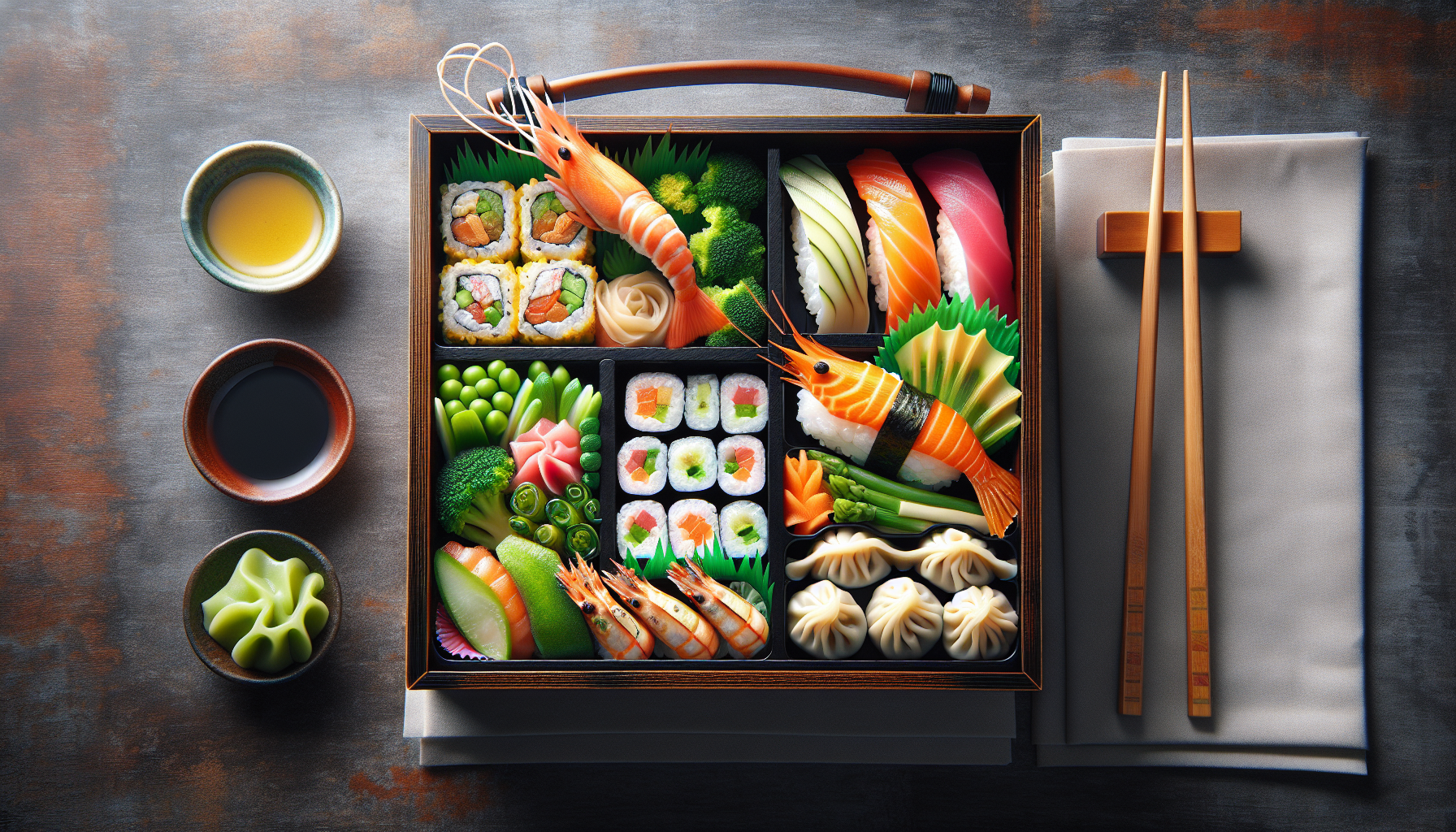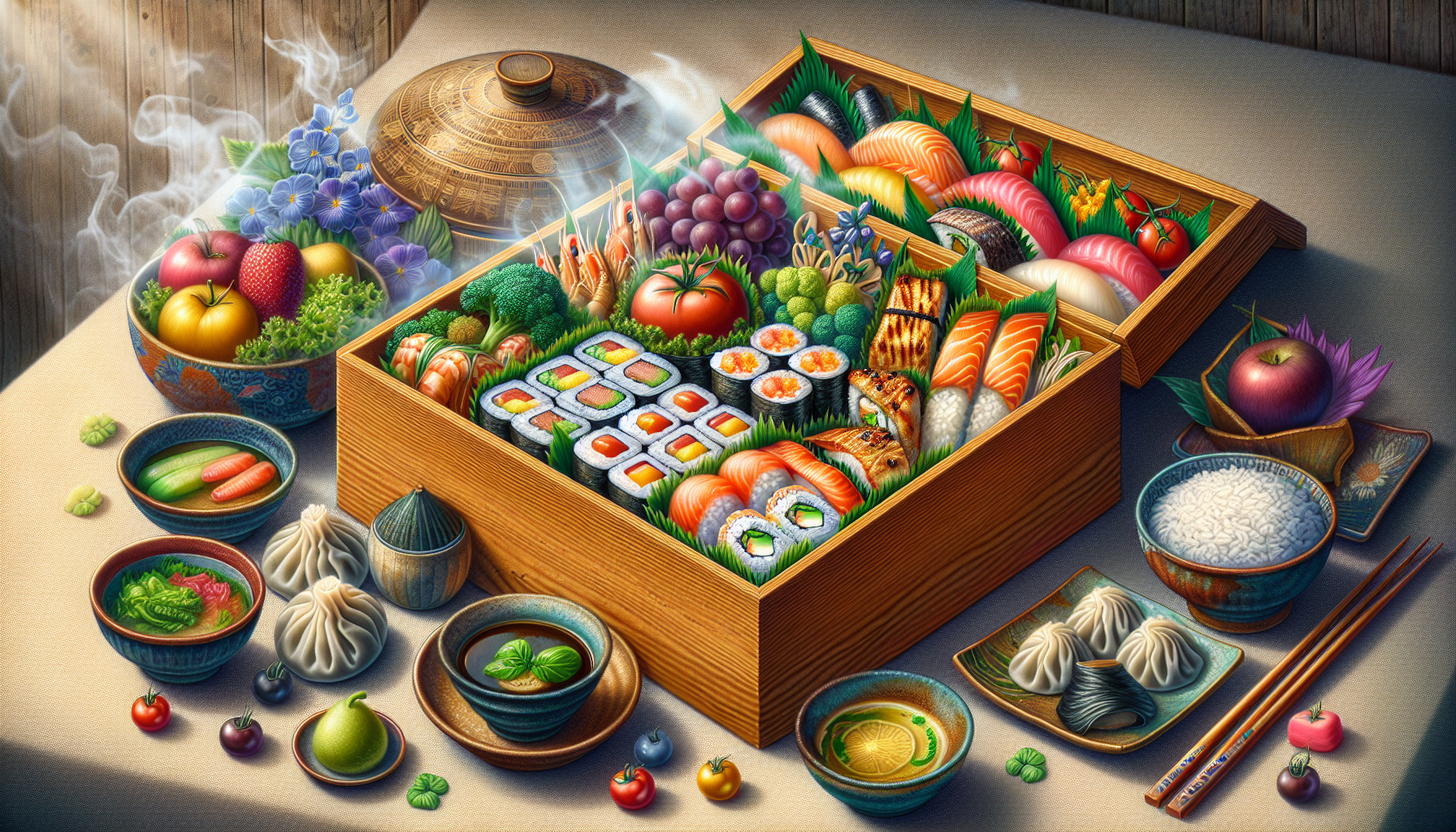Are you looking for a delicious and healthy meal option that will transport you to the vibrant streets of Japan? If so, we have just the article for you! Discover the wonders of Japanese cuisine and explore a variety of light and nutritious recipes that will tantalize your taste buds. From flavorful sushi rolls to refreshing miso soup, we have compiled a list of our favorite Japanese dishes that are not only easy to prepare but also good for your well-being. Get ready to embark on a culinary adventure and discover your preferred Japanese recipe for a light and healthy meal!

Sushi
Sushi is a popular Japanese dish that has gained immense popularity worldwide. It is not only delicious but also offers a healthy option when it comes to satisfying your hunger. There are various types of sushi, and each has its own unique flavors and combinations. Let’s explore some of the most popular types of sushi.
Maki Rolls
Maki rolls are perhaps the most well-known and widely consumed sushi in the world. These rolls consist of a layer of rice and other ingredients wrapped in seaweed. One of the most famous maki rolls is the California Roll, which typically includes avocado, cucumber, and crab or imitation crab. Another popular choice is the Spicy Tuna Roll, which combines fresh tuna with a touch of spicy mayo for an added kick. Maki rolls are not only flavorful but also easy to eat, making them the perfect choice for sushi beginners.
Nigiri
Nigiri is a traditional type of sushi that consists of a small ball of rice topped with a slice of raw fish or seafood. The simplicity of nigiri allows the flavors of the fish to shine through. Tuna nigiri is a classic choice and is widely loved for its firm texture and rich taste. Salmon nigiri is another favorite, offering a slightly buttery and delicate flavor. Nigiri is often served with a small amount of wasabi between the fish and the rice, adding an extra layer of heat and flavor.
Temaki
If you prefer a more interactive sushi experience, then temaki is the way to go. Temaki, also known as hand rolls, are cone-shaped sushi filled with rice, fish, and vegetables. They are typically wrapped in seaweed and enjoyed by hand. One popular temaki option is the Spicy Shrimp Hand Roll, which combines crispy tempura shrimp with spicy mayo and fresh vegetables. The unique shape and combination of flavors make temaki a fun and delicious choice for sushi lovers.
Sashimi
Sashimi is another beloved Japanese dish that offers a light and healthy option for seafood enthusiasts. Unlike sushi, sashimi does not involve rice or other fillings. Instead, it focuses solely on the thinly sliced, fresh fish or seafood itself. Let’s explore some popular choices of sashimi.
Tuna Sashimi
Tuna sashimi is a true delight for seafood lovers. The deep red color and tender texture of the fish make it visually appealing, while its rich and buttery flavor keeps you coming back for more. Tuna sashimi is often served with soy sauce, wasabi, and pickled ginger to enhance its taste.
Salmon Sashimi
Salmon sashimi is another favorite among sashimi enthusiasts. This fish offers a delicate texture and a mild, buttery flavor. The vibrant orange color of the salmon adds a beautiful visual element to any sashimi platter. Pair it with soy sauce and a touch of wasabi to elevate the taste.
Octopus Sashimi
For those seeking a more adventurous sashimi experience, octopus sashimi is a unique choice. The tender yet slightly chewy texture of octopus, combined with its mildly sweet and salty flavor, creates a truly distinctive taste. Octopus sashimi is often served with a citrus-based sauce, such as ponzu, to add a tangy kick to the dish.
Miso Soup
Miso soup is a traditional Japanese soup made from fermented soybean paste, known as miso, combined with a savory broth and various ingredients. It is a comforting and nourishing dish that can be enjoyed on its own or as a side dish. Let’s explore some popular varieties of miso soup.
Traditional Miso Soup
Traditional miso soup typically consists of miso paste, tofu, seaweed, and scallions. The miso paste gives the soup a rich umami flavor, while the tofu adds a mild and silky texture. The seaweed provides a subtle oceanic taste, and the scallions contribute a refreshing hint of onion flavor. Traditional miso soup is a comforting and well-balanced dish perfect for any time of the day.
Tofu and Wakame Miso Soup
For a heartier miso soup option, tofu and wakame miso soup is an excellent choice. In addition to the classic ingredients of traditional miso soup, this variation includes tofu and wakame seaweed. The tofu adds protein and a satisfying texture, while the wakame seaweed provides a slightly sweet and briny taste. This combination creates a nutritious and fulfilling miso soup that is both light and healthy.
Clam Miso Soup
If you enjoy seafood, clam miso soup is a delightful option. The clams add a distinct and slightly briny taste to the miso soup, enhancing its overall flavor profile. The tender clams, along with the miso paste and other traditional ingredients, create a comforting soup that is packed with both taste and nutritional value. Clam miso soup is a great choice when you want to indulge in a light and savory seafood dish.
Tempura
Tempura is a popular Japanese dish where various ingredients, such as seafood and vegetables, are coated in a light batter and deep-fried to crispy perfection. Despite being deep-fried, tempura is surprisingly light and delicate, making it a delightful option for a light and healthy meal. Let’s explore some popular tempura choices.
Shrimp Tempura
Shrimp tempura is a classic and widely adored tempura dish. The shrimp is coated in a thin, crispy batter and lightly fried, resulting in a perfectly golden and succulent morsel. The contrast between the crispy exterior and the tender, juicy shrimp inside creates a delightful textural experience. Shrimp tempura is often served with a dipping sauce and a side of grated daikon radish for added freshness.
Vegetable Tempura
For those seeking a vegetarian or plant-based option, vegetable tempura is a fantastic choice. A variety of vegetables, such as sweet potatoes, zucchini, and bell peppers, are sliced and lightly battered before being fried to a crispy finish. Vegetable tempura offers a colorful and flavorful combination while providing a satisfying crunch. Enjoy it with a dipping sauce or simply on its own.
Mixed Tempura
If you can’t decide between seafood or vegetables, why not have both? Mixed tempura allows you to enjoy the best of both worlds by featuring a combination of shrimp and various vegetables. This option provides a balance of flavors and textures, offering a satisfying and well-rounded tempura experience. Mixed tempura is often served with a dipping sauce and compliments a bowl of rice or soba noodles perfectly.

Yakitori
Yakitori is a type of Japanese grilled skewer dish that originated from street food stalls. These skewers are typically made with various meats, vegetables, or seafood, and are grilled over an open flame, resulting in a delicious smoky flavor. Let’s explore some popular yakitori choices.
Chicken Yakitori
Chicken yakitori is one of the most beloved and commonly consumed yakitori varieties. Tender pieces of chicken, usually thigh or breast meat, are skewered and grilled to perfection. The chicken is marinated in a flavorful sauce, often made with soy sauce, mirin, and sake, which enhances its taste and tenderness. Chicken yakitori is not only delicious but also a lean and healthy protein option.
Beef Yakitori
If you prefer a heartier option, beef yakitori is an excellent choice. This yakitori variation features tender beef pieces, such as sirloin or skirt steak, marinated in a savory sauce. The grilling process adds a smoky aroma and caramelization to the beef, intensifying its flavor profile. Beef yakitori offers a satisfying and succulent experience, making it a favorite among meat lovers.
Vegetable Yakitori
For a vegetarian or plant-based option, vegetable yakitori is a flavorful alternative. A variety of vegetables, such as bell peppers, mushrooms, and zucchini, are skewered and grilled to perfection. The grilling process brings out the natural sweetness and smokiness of the vegetables, offering a delightful combination of flavors and textures. Vegetable yakitori is a versatile dish and can be customized to suit your preferences.
Oyakodon
Oyakodon is a classic Japanese dish that consists of a bowl of rice topped with simmered chicken and egg. The name “oyakodon” literally translates to “parent and child bowl,” as it symbolizes the combination of chicken and egg. Despite its simplicity, oyakodon offers a comforting and well-balanced meal option. Let’s explore some popular oyakodon choices.
Chicken Oyakodon
Chicken oyakodon is the most common and traditional variation of this dish. It features tender chicken pieces simmered in a savory sauce, along with onions, and a lightly beaten egg. The heat from the simmering process gently cooks the egg, creating a silky and custard-like texture. Chicken oyakodon is a warm and satisfying dish that combines the flavors of the chicken, onion, and egg into a delightful harmony.
Tofu Oyakodon
For a vegetarian or plant-based option, tofu oyakodon is a great choice. Instead of chicken, tofu is used as the protein source in this variation. The tofu is simmered in the same savory sauce, along with onions and egg, creating a flavorful and nutritious dish. Tofu oyakodon offers a lighter and milder taste compared to its chicken counterpart, making it an excellent option for those seeking a plant-based alternative.
Salmon Oyakodon
Salmon oyakodon puts a seafood twist on the classic recipe. It features tender pieces of salmon simmered in the savory sauce, along with onions and egg. The salmon offers a rich and buttery flavor, which pairs beautifully with the sweetness of the onions and the creaminess of the egg. Salmon oyakodon provides a healthy dose of omega-3 fatty acids and satisfying flavors in one bowl.

Sukiyaki
Sukiyaki is a popular Japanese hot pot dish that consists of thinly sliced meat, noodles, vegetables, and tofu cooked in a sweet and savory soy-based broth. This flavorful and hearty dish is perfect for a cozy and comforting meal option. Let’s explore some popular sukiyaki choices.
Beef Sukiyaki
Beef sukiyaki is the most traditional and well-known variety of this dish. Thinly sliced beef, often marbled with fat for added richness, is simmered in a soy-based broth along with various vegetables, tofu, and noodles. The beef absorbs the flavors of the broth, becoming tender and succulent. Beef sukiyaki is typically enjoyed by dipping the cooked ingredients in beaten raw eggs, which adds a silky texture and richness to the dish.
Vegetarian Sukiyaki
For a vegetarian or plant-based option, vegetarian sukiyaki is a wonderful choice. This variation replaces the meat with a selection of mushrooms, such as shiitake and enoki mushrooms. The mushrooms add an earthy and savory taste to the broth, creating a satisfying and delicious experience. Vegetarian sukiyaki can be customized with your favorite vegetables and tofu, making it a versatile and nutritious meal option.
Pork Sukiyaki
Pork sukiyaki offers an alternative protein option to beef sukiyaki. Thinly sliced pork, such as pork belly or loin, is simmered in the soy-based broth, allowing it to soak up the flavors of the broth and become tender. The pork adds a distinctive flavor and texture to the sukiyaki, creating a unique culinary experience. Pair it with a bowl of steamed rice or noodles for a hearty and fulfilling meal.
Yakisoba
Yakisoba is a popular Japanese stir-fried noodle dish that is both easy to make and full of flavor. The name “yakisoba” translates to “grilled noodles,” referring to the cooking method of stir-frying the noodles on a hot plate. Let’s explore some popular yakisoba choices.
Classic Yakisoba
Classic yakisoba features stir-fried wheat noodles cooked with various ingredients, including thinly sliced pork, cabbage, carrots, and onions. The noodles are tossed in a tangy and savory sauce, often made with a combination of Worcestershire sauce, soy sauce, and ketchup. The result is a delicious medley of flavors and textures, creating a satisfying noodle dish that is perfect for any occasion.
Vegetable Yakisoba
For a vegetarian or plant-based option, vegetable yakisoba is a fantastic choice. Instead of meat, this variation focuses on an assortment of fresh vegetables, such as bell peppers, mushrooms, and bean sprouts. The vegetables add crunch, color, and a variety of flavors to the dish, making it both nutritious and delicious. Vegetable yakisoba is a versatile option that allows you to be creative with the vegetables you include.
Seafood Yakisoba
Seafood yakisoba is a delightful choice for seafood enthusiasts. This variation includes an array of seafood, such as shrimp, squid, and mussels, alongside the stir-fried noodles and vegetables. The seafood adds a unique and briny taste to the dish, elevating the overall flavor profile. Seafood yakisoba is a satisfying and flavorful option that highlights the freshness of the seafood.

Nikujaga
Nikujaga is a comforting and hearty Japanese stew that consists of thinly sliced meat, typically beef or pork, potatoes, onions, and a sweet soy-based broth. The name “nikujaga” translates to “meat and potatoes,” perfectly describing the main ingredients of this dish. Let’s explore some popular nikujaga choices.
Beef Nikujaga
Beef nikujaga is the most common variation of this stew. Thinly sliced beef is simmered in a savory and slightly sweet soy-based broth, along with potatoes, onions, and other vegetables. The slow simmering process allows the beef to become tender and the flavors of the broth to be absorbed, creating a rich and comforting dish. Beef nikujaga is often served with a bowl of steamed rice, providing a well-rounded and satisfying meal.
Pork Nikujaga
Pork nikujaga offers an alternative meat option to beef. Thinly sliced pork, such as pork belly or shoulder, is cooked in the same savory broth, resulting in a tender and flavorful dish. The pork adds its unique taste and texture to the nikujaga, enhancing the overall culinary experience. Pork nikujaga is a comforting and filling option, perfect for colder days or when you need a nourishing meal.
Vegetarian Nikujaga
For a vegetarian or plant-based option, vegetarian nikujaga is an excellent choice. This variation replaces the meat with a selection of vegetables, such as mushrooms, carrots, and green beans. The vegetables are simmered in the sweet soy-based broth, resulting in a flavorful and wholesome stew. Vegetarian nikujaga is a versatile dish that allows you to customize the vegetables and create a nutritious meal that suits your preferences.
Gyoza
Gyoza is a Japanese dumpling that originated in China and has become a beloved dish in Japanese cuisine. These dumplings are typically filled with a mixture of ground meat, such as pork, vegetables, and seasonings, before being pan-fried to create a crispy exterior and a juicy interior. Let’s explore some popular gyoza choices.
Pork Gyoza
Pork gyoza is the most common and traditional variety of this dumpling. The filling consists of ground pork, cabbage, garlic, ginger, and various seasonings, which are wrapped in a thin sheet of dough. The gyoza is then pan-fried until the bottom is crispy, and the top is tender. Pork gyoza offers a satisfying combination of flavors and textures, with the savory meat filling complemented by the crispy dumpling skin.
Vegetable Gyoza
Vegetable gyoza is a fantastic option for those looking for a vegetarian or plant-based alternative. The filling is made with a variety of vegetables, such as cabbage, carrots, mushrooms, and spring onions. The vegetables are finely chopped and seasoned before being wrapped in the dough. The pan-frying process creates a golden and crispy exterior, while the vegetables inside remain tender and flavorful. Vegetable gyoza is a tasty and nutritious option that can be enjoyed by everyone.
Shrimp Gyoza
For seafood enthusiasts, shrimp gyoza is a delectable choice. The filling is made with a combination of shrimp, vegetables, and seasonings, creating a flavorful and succulent dumpling. The delicate and slightly sweet taste of the shrimp complements the crispy exterior of the gyoza perfectly. Shrimp gyoza is a refreshing and satisfying option that adds a unique twist to the traditional dumpling.
In conclusion, Japanese cuisine offers a wide range of light and healthy meal options, each with its own distinctive flavors and combinations. Whether you prefer sushi, sashimi, soups, stir-fried noodles, grilled skewers, comforting stews, or dumplings, there is a Japanese recipe to suit every taste and dietary preference. So why not step out of your culinary comfort zone and indulge in the vibrant and nourishing world of Japanese cuisine for your next light and healthy meal?

